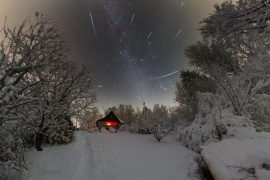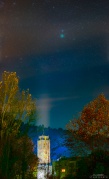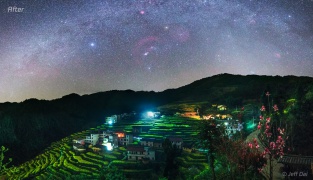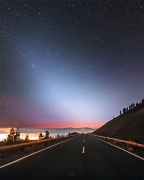Getting Started in Astrophotography
NOTE: this is a page in progress
A lot of people have at least a casual interest in Astrophotography (abbreviated AP). But most people know very little about how AP is done, or what it even is. Many seem to think it's as simple as just plugging a camera into the eyepiece receptacle of a telescope and snapping pictures. In reality, it's far more complex than that.
Contents
What is Astrophotography
At its heart, AP is about taking pictures of astronomical phenomena. This can be anything from images of the stars at night to images of galaxies and nebulae, and a whole bunch of stuff in-between.
Astrophotography is not a monolithic subject. There are a wide variety of sub-topics in AP, and each have different needs. There's no one-size-fits-all solution. But there is often a lot of overlap.
Let's break down the different kinds of AP:
Kinds of Astrophotography
Nightscape Photography
Nightscape photography is the type of astrophotography that combines scenery/landscape photography with the night sky overhead.
- Examples of Nightscape Photography From APOD
Nightscape photography is primarily done with DSLR cameras, non-tracking tripods, and standard lenses with short focal lengths.
Lunar Photography
As the name suggests, this would be pictures of the moon.
Other than the sun, the moon is the brightest of all astrophotography targets. It's also relatively large. Long exposure imaging is not required for lunar photography, so a tracking mount is not required, though it is generally recommended. The preferred method for lunar photography is done via stacking video frames and processing to produce the most detail.
Planetary Photography
Again, as the name suggests, we're talking about pictures of planets here.
For the most part, however, there are only three planets that make good targets for photography: Mars, Jupiter, and Saturn.
•Mercury is too close to the sun, and too small. At its [maximum elongation], it only gets about 19° from the sun, which means that it's never visible far above the horizon. Because of this, any imaging will end up shooting through a thicker air mass, which typically degrades the image significantly. It's also so small that you're not going to see much anyway it its distance. Nevertheless, some people do attempt pictures. In them the most you are likely to see is the phases it displays, similar to those of the moon.
•Venus is not as close to the sun as is Mercury, but, being inside our orbit, it still doesn't rise all that high. At [maximum elongation], it only gets about 45° above the horizon. Venus is also fairly featureless, other than showing phases. The clouds block any surface features, and the patterns in the clouds themselves tend to be fairly subtle. Typically you would need a neutral density filter to reduce the glare, then another filter (I believe violet is the one of choice) to increase contrast enough to make out the features.
•Uranus is too distant and small to show much more than a blue-green disk to most amateur telescopes. Larger amateur scopes can occasionally get more out of it, but rarely.
•Neptune is about the same size as Uranus, but further out still, making any reasonable hope for capturing an image of Neptune somewhat hopeless.
•And if you count Pluto as a planet, just consider that the best image the HST could get is this:
As for extra solar planets: only the largest research telescopes have ever captured direct images of the most massive and nearby such stars. Your amateur scope has no real hope of imaging them, though detecting them is possible.
Comet Photography
Comet astrophotography comes along with some unusual challenges.
There are actually two different kinds of comet astrophotography. The first kind is primarily used for discovering comets. The other is to produce an image of the comet.
Photography for discovering comets - which can also be used for discovering asteroids or even Kuiper Belt Objects (KBOs) and was also the technique used to discover Pluto - involves capturing multiple images of the same patch of sky over time. It can be done during a single imaging session or over several. The images are then compared in an effort to identify any objects that appear to move between the images. The discovery of Pluto utilized a device called a Blink Comparator, which rapidly shifted between images. Today, typically images are merged and a moving object will show up in multiple positions, typically forming a line as it moves through the image.
For capturing detailed images of a comet, the primary challenge comes with the fact that the comet is usually moving at a different rate than the background stars. The closer the comet is to the Earth, the more apparent motion there will be between the comet and the background stars. Sometimes it may take days to notice much of a change, particularly when a comet is far away. Other times, particularly when closest, the movement may seem obvious over minutes or seconds. In a case like this, if trying to capture a long-exposure image, normal tracking at the sidereal rate will show the stars as you would normally expect to see them, but the comet may appear to be a stretched blur. If you were to track the comet directly, the comet may come out clear, but then the background stars would end up in a blur.
For this reason, special techniques are used for this kind of imaging.
Solar Photography
Due to the intensity of the energy involved, solar photography requires some form of filtering to avoid damaging the camera and/or telescope. As with lunar and planetary imaging, exposure times are very short, so mount selection is far less critical. But the filtration option itself can be expensive, depending on the type of solar filtering used.
There are two main types of solar filters: so-called "White Light" filters and Hα filters.
White-light filters are fairly inexpensive, but also show the least. A white light solar filter will allow you to see sunspots, transits, and possibly solar granulation (though not clearly).
Hα filters are a whole different ballgame. These combine an energy rejection filter with an etalon which allows for a very narrow bandwidth of light to be viewed. This allows the viewer to see a lot more detail at a specific wavelength of light. This allows the user to see things such as solar prominences (these are frequently, though incorrectly, referred to as solar flares, but flares are a much larger feature). There are other, similar filters for different wavelengths. Calcium K is the second most common such filter, though the vast majority of narrow-band solar filters for amateurs are Hα.
Deep Sky Photography
The biggest challenges in AP come with deep sky astrophotography, or DSO AP. There are two key inter-related reasons for this.
The Earth rotates on its axis once every 24 hours. When you factor in the additional movement caused by the Earth's orbit around the sun, the actual apparent rate of motion of astronomical objects in the sky is about 4 minutes short of 24 hours. This is the sidereal rate.
DSO targets include galaxies, nebulae, and star clusters. Each of those can, of course, be sub-divided.
The easiest overall division here to use is by Angular Measure. Targets which require a wider field of view (for example NGC 7000, the North America Nebula M31, the Andromeda Galaxy, and the Veil Nebula)
LEVEL 1
Level 1
LEVEL 2
Level 2
LEVEL 3
Level 3
LEVEL 4
Level 4
LEVEL 5
Level 5





